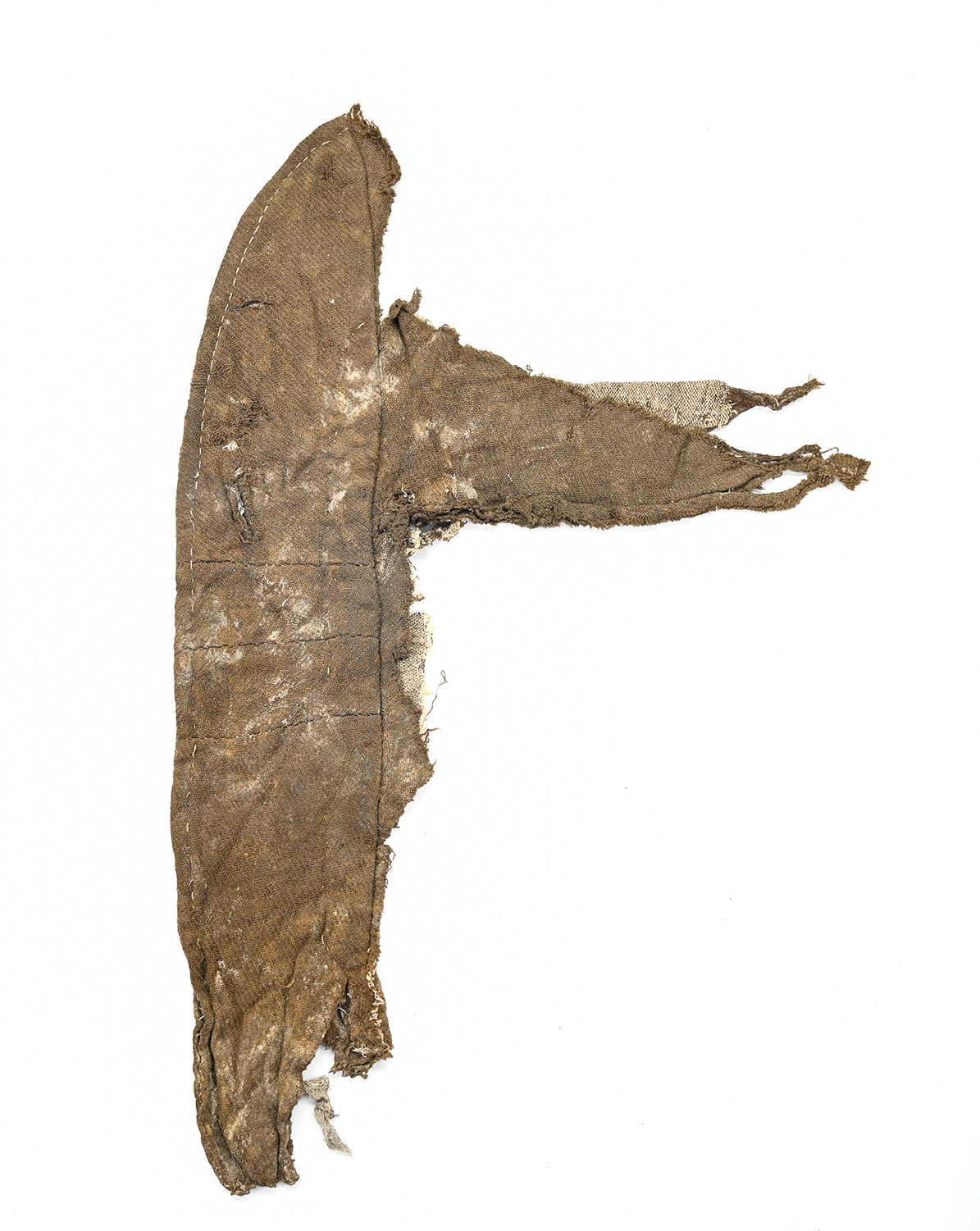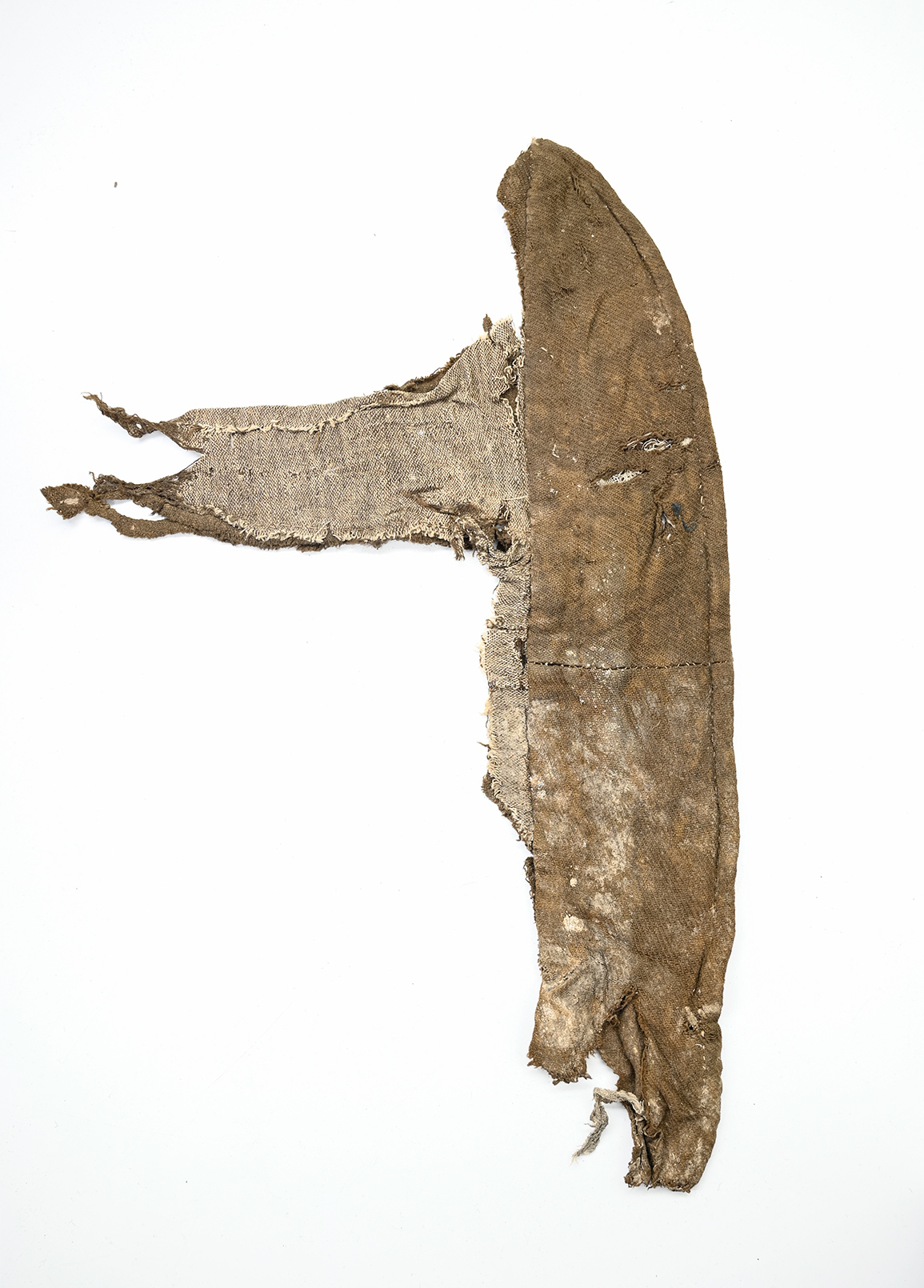site search
online catalog
MODEL 1872 FATIGUE BLOUSE FRAGMENT: FORT PEMBINA

Hover to zoom


$295.00
Quantity Available: 1
Item Code: 1052-598
Shipping: Determined by Method & Location of buyer
To Order:
Call 717-334-0347,
Fax 717-334-5016, or E-mail
This appears to be the rollover collar and portion of the chest from a M1872 fatigue blouse. This was pleated nine-button blouse piped on the collar and cuff, made in lined and unlined versions, with three pockets. The general idea was to give the soldier greater freedom of movement and enable him to wear it on its own in hot weather and in cold weather to layer his undergarments. The pleats, however, had rather too “frilly” a look for many soldiers, the garment was never popular, and in 1874 the army went back to a variation on the Civil War sack coat.
This fabric comes from the excavations at Fort Pembina, ND, conducted on private property with the owner’s permission, where wet, anaerobic soil conditions have yielded leather gear and cloth in remarkable states of preservation, though usually with changes in color, most of the blue fabrics shifting toward green as here. The piece was obviously torn from a garment, likely worn out, with portions salvaged for patching or simply for use as cleaning rags, etc.
Fort Pembina was established in 1870 by troops of the 20th US Infantry and as is typical of the early Indian Wars regular army, their issue uniforms were Civil War surplus well into the 1870s. Situated in the Red River Valley in North Dakota near the Canadian border, Ft. Pembina was in operation until 1895. Trading posts existed earlier in the area as part of the fur trade, and the first U.S. military post there was temporary- manned by a detachment of Minnesota troops in 1863-1864 following the 1862 Sioux uprising. In March 1870 a new fort was established south of the Pembina River and about 200 yards west of the Red River, completed by July and named in honor of Gen. George H. Thomas. The name was changed to Fort Pembina in September and the initial garrison consisted of two companies of the 20th US Infantry. Their main purpose was to provide security for settlers worried about Sioux returning south from Canada, but the troops spent much of their time escorting boundary surveys along the Canadian border and preventing Fenian raids heading north into Canada.
The fort included enlisted barracks, officers’ quarters, guard house, ordnance storehouse, company kitchen, root house, laundress’s quarters, quarters for civilian employees, hospital and hospital servant’s house, a barn for the “hospital cow,” quartermaster and commissary offices and storehouse, stables, wagon shed, etc. The garrison reached peak strength in 1878 of 200, but the average was about 125 enlisted men and 8 officers. An October 1885 return listed 97 men, 2 field pieces, 1 mountain howitzer, 100 rifles, 19 pistols, 23 mules, and 9 wagons. By 1890 the post had just 23 men, and after an 1895 fire destroyed some 19 buildings it was decided to abandon the fort rather than rebuild, the last detachment left in September. The property was turned over to the Interior Department and later sold in 1902.
This piece is stable, displays very well, is a scarce relic of army life on the frontier and would make an interesting study piece of the postwar army’s material culture. [sr] [ph:m]
~~~~~~~~~~~~~~~~~~~~~~~~~~~~~~~~~~~
THIS ITEM, AS WITH ALL OTHER ITEMS AVAILABLE ON OUR WEB SITE,
MAY BE PURCHASED THROUGH OUR LAYAWAY PROGRAM.
CLICK HERE FOR OUR POLICIES AND TERMS.
THANK YOU!
Inquire About MODEL 1872 FATIGUE BLOUSE FRAGMENT: FORT PEMBINA
Most Popular
Historical Firearms Stolen From The National Civil War Museum In Harrisburg, Pa »
Theft From Gravesite Of Gen. John Reynolds »
Selection Of Unframed Prints By Don Troiani »
Fine Condition Brass Infantry Bugle Insignia »
featured item
WOUNDED AT GETTYSBURG! 1/6 PLATE AMBROTYPE OF PVT. AURELIUS JAMES DULA, 22ND NORTH CAROLINA
Sixth plate hand-gilt ambrotype. Leatherette case. Anonymous artist. North Carolina. Private Aurelius James “A.J.” Dula (1843 - 1913), a member of Company A (the "Caldwell Rough and Ready Boys”) of the 22nd North Carolina Infantry. A native… (846-577). Learn More »
site search
Upcoming Events
The shop is currently closed so that we may conduct our annual inventory. We are available by phone… Learn More »


